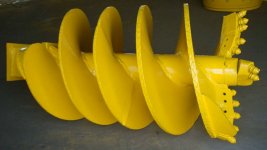RC Mech
Stainless
- Joined
- Jul 21, 2014
- Location
- Ontario, Canada
I've built many different types of rock drills, pilots and augers over the years. Larger diameters, up to 96". Core-barrels too. Usually the construction is 1045 steel for the barrel/chisel edges, and Bauer (sp?) pockets welded in place. According to independent testing, I've been told by people a few links removed from the source that the Bauer pockets are 300Rc. I believe they are confusing Rockwell with Vickers.
In any event, I'd like to try to make some rock auger edges out of a harder steel than 4140. The current iterations are 4140HT, machined while annealed. Hardened and stress relieved to 35Rc. My heat treater said that it's very difficult to get a narrow/reasonable hardness range for 1045; 4140 on the other hand can be HT to within 2Rc. My chem background tells me this is due to the increased Chromium content of 4140 and the questionable consistency of 1045.
If I want an extremely hard yet durable rock edge into which to machine pockets for bullet teeth, what material should I use? I don't trust the current 35Rc 4140 versions. My thoughts:
1: Machine of 4140 and HT to 50Rc
2: Try AR400 and hate life all the while machining it and then HT to 50Rc
3: Change processes and sinter them like the Bauer pockets are.
4: Use a different material and machine?
Thanks for any advise or expertise.
In any event, I'd like to try to make some rock auger edges out of a harder steel than 4140. The current iterations are 4140HT, machined while annealed. Hardened and stress relieved to 35Rc. My heat treater said that it's very difficult to get a narrow/reasonable hardness range for 1045; 4140 on the other hand can be HT to within 2Rc. My chem background tells me this is due to the increased Chromium content of 4140 and the questionable consistency of 1045.
If I want an extremely hard yet durable rock edge into which to machine pockets for bullet teeth, what material should I use? I don't trust the current 35Rc 4140 versions. My thoughts:
1: Machine of 4140 and HT to 50Rc
2: Try AR400 and hate life all the while machining it and then HT to 50Rc
3: Change processes and sinter them like the Bauer pockets are.
4: Use a different material and machine?
Thanks for any advise or expertise.


